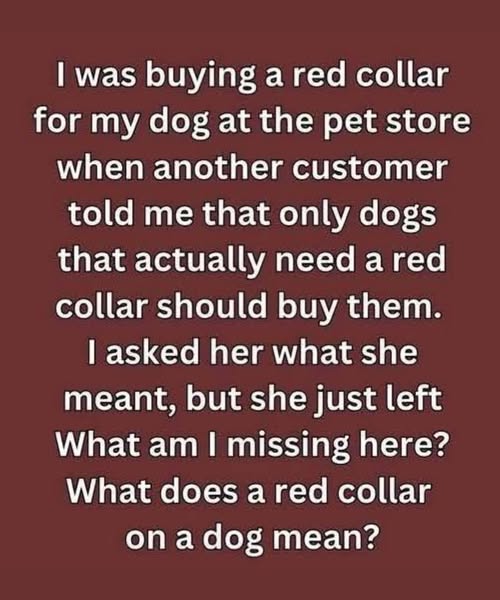In many dog training, behavior, and rescue communities, red collars or red leashes have become more than just a fashion statement—they serve as an important visual cue, a form of silent communication between dog owners and the people around them. The idea is simple yet vital: a red collar signals that a dog needs space. Typically, this could mean that the dog is reactive, fearful, aggressive, in training, or simply not comfortable with strangers or other dogs approaching. For owners, the red collar acts as a gentle, preemptive warning to anyone nearby to give the dog room and to respect its boundaries. It’s a precaution, a visual language developed through observation and experience within dog-loving communities.
When the woman at the store said, “Only dogs that actually need a red collar should buy them,” she was referencing this unspoken yet widely recognized code. To many dog owners, it’s more than just color—it’s a message, an alert, a statement about a dog’s behavior and the need for personal space. Wearing or displaying a red collar when a dog doesn’t actually require one could inadvertently mislead others. It’s not merely about aesthetics; it’s about safety, respect, and communication within the dog-owning community.
This is likely why your roommate reacted strongly. In circles where these color-coded systems are understood, using a red collar on a friendly or non-reactive dog might generate confusion, unnecessary concern, or even frustration. People may avoid approaching your dog, assuming it is reactive, or they may misjudge its temperament and behave cautiously when there is no actual need to do so. While the color itself is harmless, the associations and social conventions surrounding it carry weight and meaning, especially among dog trainers, volunteers at shelters, or those who frequently walk multiple dogs in public spaces.
Different collar or leash colors often carry distinct implications, which, though not universal, are widely recognized among dog-savvy communities. Here’s a breakdown of what these colors generally signify:
Red: “I need space” / “Do not approach.” Often reserved for dogs that may react aggressively, are fearful, or are in behavioral training.
Yellow: “I am nervous” or “I may be anxious.” Approach with caution, speak softly, and avoid sudden movements.
Green: “Friendly” and open to interaction. A green collar signals a dog that is approachable, social, and comfortable around strangers or other dogs.
Purple: “Do not feed.” This is particularly useful for dogs with dietary restrictions or medical conditions, where feeding without permission could be harmful.
White: Typically used for dogs who are deaf or blind, alerting others to approach differently and to communicate through non-verbal cues.
Blue: Often reserved for working or service dogs, signaling that the dog is focused on a task and may not respond to social interaction.
Understanding these signals can help dog owners navigate public spaces safely, minimize misunderstandings, and ensure that dogs—especially those with behavioral sensitivities—are protected from potentially stressful encounters.
So what does this mean for you and your dog, Pecan? If Pecan is friendly, calm, and non-reactive, there’s absolutely no law or strict rule preventing you from using a red collar. However, you should be aware that it might send the wrong signal to others who recognize the color code. People might give your dog unnecessary space, avoid interaction, or even misinterpret Pecan’s behavior. If your main goal was simply aesthetic—if you liked the red color and it looked good on Pecan—you might want to consider alternatives that maintain the same visual appeal without conveying an unintended message. Colors such as blue, green, or even orange could be stylish while being neutral in the context of behavior signaling.
It’s also worth noting that these signals are context-dependent. Not everyone recognizes these color codes, and casual dog owners or members of the public may not even notice. But among communities where safety, training, and dog behavior awareness are prioritized, these subtle signals matter. They help prevent accidents, reduce stress for dogs, and create a more harmonious environment for everyone involved.
Ultimately, using a red collar responsibly requires understanding its symbolic meaning and being considerate of how it may be interpreted. If Pecan truly needs space due to training, behavioral issues, or anxiety, a red collar is a valuable tool for communicating this need. But if Pecan is calm and social, selecting a color without behavioral connotations ensures that the message you’re sending aligns with the reality of your dog’s temperament.
In conclusion, color-coded collars and leashes are more than a simple fashion choice—they’re a nuanced form of non-verbal communication within the dog community. Red means “give me space,” yellow means “approach with caution,” green says “I’m friendly,” and each color carries its own subtle cues. By understanding and respecting these signals, you ensure the safety and well-being of your dog and the comfort of those around you. And for Pecan, choosing the right collar can be a small but significant step in promoting positive interactions, safe encounters, and happy experiences on every walk, visit, or outing.
